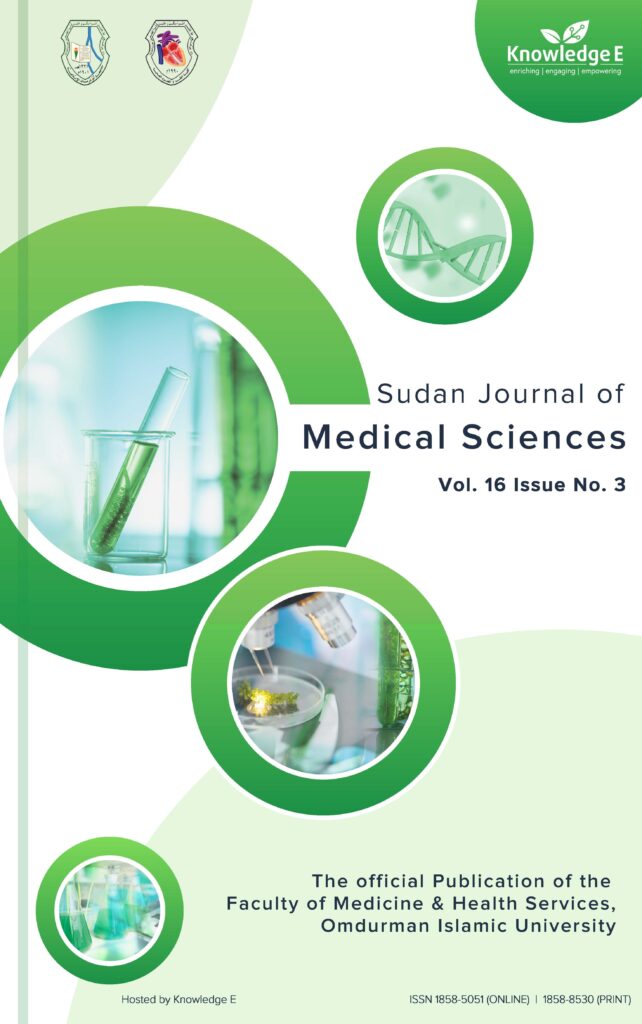
Sudan Journal of Medical Sciences
ISSN: 1858-5051
High-impact research on the latest developments in medicine and healthcare across MENA and Africa
Medical Students’ Perceptions of Online Learning During COVID-19 Pandemic in Ibn Sina University
Published date:Mar 28 2025
Journal Title: Sudan Journal of Medical Sciences
Issue title: Sudan JMS: Volume 20 (2025), Issue No. 1
Pages:61 - 71
Authors:
Abstract:
Background: The COVID-19 lockdown of Sudanese universities in March 2020 affected education at all colleges, notably medical students. Therefore, this study aimed to investigate final-year medical students’ perceptions and satisfaction with using mobile phones and Telegram at Ibn Sina University. Fortunately, these students were familiar with using mobile phones and Telegram as technological teaching and learning tools with some lecturers before the spread of COVID-19.
Methods: This evaluation-based design study was conducted from March to June 2020. A diagnostic test and a questionnaire were used to collect data. The diagnostic test consisted of five multiple choice questions (MCQs) on Control Infection Measures. The questionnaire consisted of three sections: (i) demographic characteristics of the students; (ii) students’ learning experience; and (iii) mobile learning design. A population of 135 students was targeted and a convenience sample of 40 medical students in their final fifth year voluntarily participated in this study. The questionnaire data were analyzed using SPSS, while the diagnostic test data were analyzed by comparing pass rates per item.
Results: The findings of the diagnostic test revealed that 94% of the students learned about what infections are, where they come from, and how to prevent them; 66% learned about standard precautions; 56% understood how to break the chain of infection; and 53% succeeded in recognizing diseases that are transmitted by infection, thus, they were aware about the epidemic process of an infectious disease. Students enhanced their knowledge of personal hygiene and built personal skills, experiences, and practices for reducing infection. The questionnaire findings revealed that the students showed positive perceptions, strong satisfaction, and positive learning experiences with a percentage score ranging from 67.5% to 95% indicating that they “agree” and “strongly agree,” respectively. Moreover, 75% of the students were able to get advice from their instructors whenever they needed and had the opportunity to study, gain knowledge, and interact with their peers successfully. Additionally, 82.5% of the students preferred asynchronous learning and teaching.
Conclusion: Mobile phones and the Telegram App have been accepted well by the students as indicated by the results of the present study and may be used more for academic activities. It is recommended that these tools can broadly be adopted in medical education due to their positive potential during this research.
Keywords: COVID-19, medical students, online learning, perceptions, knowledge
References:
[1] Gacs, A., Goertler, S., & Spasova, S. (2020). Planned online language education versus crisis- prompted online language teaching: Lessons for the future. Foreign Language Annals, 53(2), 380–392. https: //doi.org/10.1111/flan.12460
[2] Sara, R., & Oifaa, T. (2020). Emergency remote learning in higher education during COVID-19 era: Students and professors’ experiences. Linguistic Forum, 2(4), 13–19. https://doi.org/10.53057/linfo/ 2020.2.4.2
[3] Salhab, R., & Daher, W. (2023). University students’ engagement in mobile learning. European Journal of Investigation in Health, Psychology and Education, 13(1), 202–216. https://pubmed.ncbi.nlm.nih.gov/36661766/. https://doi.org/10.3390/ejihpe13010016
[4] Ibnouf, M. A. M. (2021). Editorial-university staff and student protection from COVID-19: Strategic measures for teaching and learning in resourcelimited setting. Sudan Journal of Medical Sciences, 16(1), 1–4. https://doi.org/10.18502/sjms.v16i1.8932
[5] Gyane, S. O. J. (2021). Perceptions of students on the use of Telegram during the COVID-19 pandemic [AIM]. Acta Informatica Malaysia, 5(1), 21– 24. https://doi.org/10.26480/aim.01.2021.21.24
[6] Kite, J., Schlub, T., Zhang, Y., Choi, S., Craske, S., & Dickson, M. (2020). Exploring lecturer and student perceptions and use of a learning management system in a postgraduate public health environment. E-Learning and Digital Media, 17(3), 183–198. https: //doi.org/10.1177/2042753020909217
[7] Koole, M. (2009). A model for framing Mobile learning. In M. Ally (Ed.), Mobile learning: Transforming the delivery of education and training (Chapter 2, pp. 25–47). AU Press. https://www.researchgate.net/ publication/252714629
[8] Koole, M., Buck, R., Anderson, K., & Laj, D. (2018). A comparison of the uptake of two research models in mobile learning: The FRAME model and the 3-level evaluation framework. Education Sciences, 8(3), 114. https://doi.org/10.3390/educsci8030114
[9] Hamadi, M., El-Den, J., Sriratanaviriyakul, N., & Azam, S. (2021). A social media adoption framework as pedagogical instruments in higher education classrooms. E-Learning and Digital Media, 18(1), 55– 85. https://doi.org/10.1177/2042753020950869
[10] Abdelrahman, K., Nasser, A., Atwa, H., Mostafa, A., Eman, G., & Metwally, E. (2022). Undergraduate medical students’ perception of online learning and assessment during the COVID-19 pandemic: An Egyptian experience. Egyptian Society of Clinical Toxicology Journal, 10(2), 90-103. https://doi.org/10.21608/esctj.2022.176291.1018
[11] Habes, M., Elareshi, M., Salloum, S. A., Ali, S., Alfaisal, R., Ziani, A., & Alsridi, H. (2022). Students’ perceptions of mobile learning technology acceptance during Covid-19: WhatsApp in focus. Educational Media International, 59(4), 288–306. https://doi.org/ 10.1080/09523987.2022.2153990
[12] Alzahrani, H. A., Shati, A. A., Bawahab, M. A., Alamri, A. A., Hassan, B., Patel, A. A., Ahmad, M. T., El Maksoud, W. A., & Alsaleem, M. A. (2023). Students’ perception of asynchronous versus synchronous distance learning during COVID-19 pandemic in a medical college, southwestern region of Saudi Arabia. BMC Medical Education, 23(1), 53. https://doi.org/10.1186/s12909-023-04034-5
[13] Krasulia, A., & Saks K. (2020). Students’ perceptions towards mobile learning in an English as a foreign language class. IEEE 20th International Conference on Advanced Learning Technologies (ICALT) (pp. 238–240). https://essuir.sumdu.edu.ua/handle/ 123456789/82637
[14] Yesuf, K. A. (2023). College student perception toward use of mobile learning during coronavirus disease 2019 (COVID-19) era in 2021. HT Health Technology, 7( June). https://ht.amegroups. org/article/view/8065/html
[15] Mao, S., Guo, L., Li, P., Shen, K., Jiang, M., & Liu, Y. (2023). New era of medical education: Asynchronous and synchronous online teaching during and after COVID-19. Advances in Physiology Education, 47(2), 272–281. https://doi.org/10.1152/ advan.00144.2021
[16] Rigdel, K. S., Zangmo, T., Zangmo, M., & Zangmo, T. (2024). Students’ perceptions towards mobile learning and its influence on students’ learning achievement, i-manager’s Journal of Educational Technology, 20(4), 31–43. https://doi.org/10.26634/ jet.20.4.20242